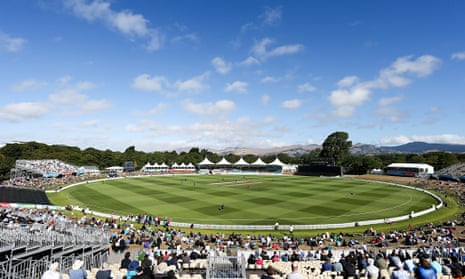The skirmishes are over, the preliminaries taken care of, and now, in the disparate settings of the Melbourne Cricket Ground and Hagley Oval in Christchurch – the former a rolling bowl of noise and tiered ranks rising up to the sky; the latter in parkland, with grassy banks surrounded by trees – the World Cup finally gets under way.
Fourteen teams, contesting a total of 49 matches in 44 days, slightly longer than it took to play the entire Big Bash tournament. And if this represents a reduction from the peak of 54 in South Africa in 2003, then it is still a glut, not least the four-week preliminary period where the 14 teams will be reduced to eight for the quarter-final knockout stage.
When it is done, the winners will not only parade around the MCG with the silver and gilt globe,the trophy commissioned for the 1999 tournament from Garrard & Co in London, but will be ready to bank a cheque for just shy of $4m (£2.6m). Just to place a perspective on this, when West Indies won the inaugural World Cup in 1975 (just 15 matches in that tournament, by the way), they received £4,000, equivalent today of around $55,000. Even the losing quarter-finalists this time will receive $300,000.
Of course, the reason is the gargantuan rise in the value of broadcasting rights (the current $1.2bn deal to 2017 is being replaced for the six years to 2023 by another of $1.9bn). Estimates say that this tournament will be watched by a television audience of upwards of 2.5 billion in more than 200 countries and territories (2.2 billion watched that last time, with 67 million watching India win the final), which would make it the third most-watched global sporting event behind the football World Cup and the summer Olympics.
This is an important tournament for the integrity of 50-over cricket. There are many who regard it as an anachronistic filler between the true game, which is to say Test cricket, and the money game, Twenty20, and that cricket no longer needs this form of the game to lend sustenance both to the purists and that audience, intrinsically different to a great extent, who enjoy the far more instant gratification of the shortest form.
The rise and success – in audience terms if not yet necessarily financial – of the various domestic T20 competitions, particularly those in India, Australia and to a lesser extent the Caribbean – could make this competition seem cumbersome by comparison. The next 50-over World Cup, in England in 2019, will see the number of participants reduced to 10, with more focus on qualification, so there is a mindfulness that too much of this competition involves treading water.
There are certainly those who believe, not without merit, that there needs to be more of an incentive in the formative stages, to make even the matches against those sides in the lower tier – in this case Ireland, Scotland, Afghanistan, and UAE as associate members along with Bangladesh and Zimbabwe of the full members – more meaningful than just a means of scooting into a quarter final.
As it stands, it is perfectly feasible that England could lose their group matches to Australia, Sri Lanka and New Zealand by a heavy margin, yet by beating Scotland, Afghanistan and Bangladesh to reach the knockout stages, produce three further wins and take the competition. That just seems incongruous.
Despite the feeling that the recent rounds of warm-up matches have been an extraneous commitment to sides such as Australia, England, New Zealand, Sri Lanka and India, all of whom have been playing in Australia and New Zealand for more than a month now, they have been instructive.
The ICC, in the form of its chief executive Dave Richardson, has been taking a much stronger line on the issues of illegal bowling actions (not before time) and, more recently, player behaviour on the field, which it is believed has been becoming unacceptable. So players have been warned that umpires and match referees have been instructed to take a stronger line if there is transgression, although this will still remain open to subjective interpretation.
More obvious, certainly during England’s two matches at the Sydney Cricket Ground, has been the imperative, from Richardson again, to increase the playing area by pushing the boundary ropes back as far as possible, this to help counter the effect of more powerful bats and mis-hit sixes. The result has been instructive: the sixes that have been hit were all cleanly struck, while the mis-hits, sixes on the postage stamps of T20 competitions, went comfortably to hand; running between the wickets and the art of creating twos and threes was revived; and bowlers felt that they had been given a chance.
There will still be run gluts as not all boundaries can be extended that far – Eden Park in Auckland, for example, which will stage the meeting between Australia and New Zealand, as well as a semi-final, has straight boundaries that, had the ground not already been established as an international venue, would not now meet the minimum ICC requirement.
In general, though, it is an excellent initiative and long overdue. Richardson has gone as far as he is able at present to reestablish a proper balance between bat and ball, and that can only be a good thing for the tournament and the game.

